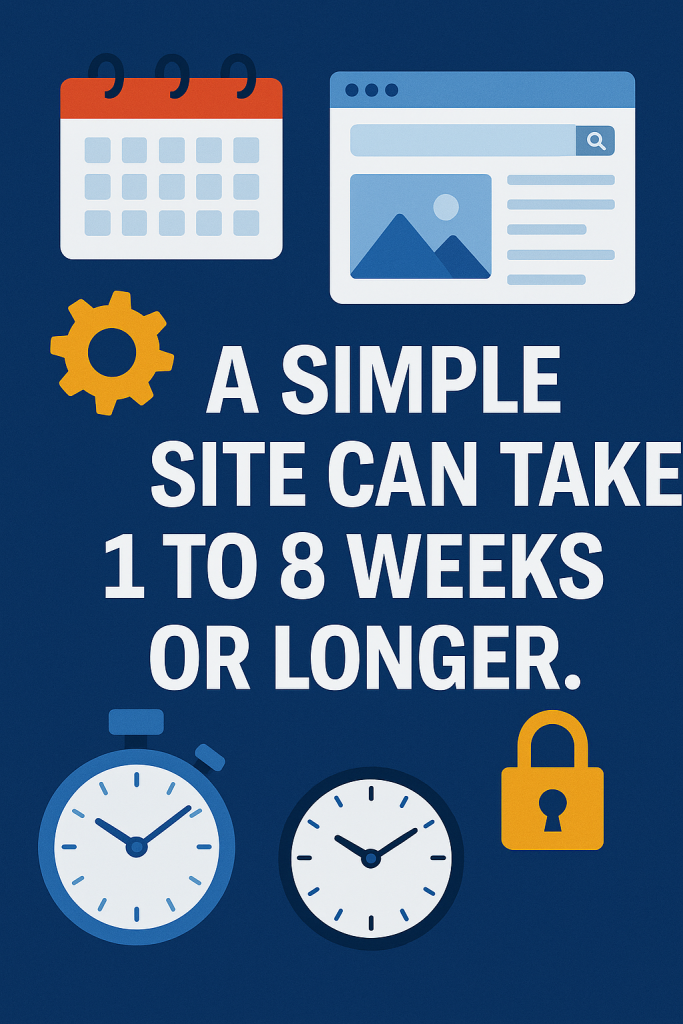
Design Steps & Typical Time Spent
- Planning (1–2 weeks) – Research, sitemap, wireframes.
- Design (2–4 weeks) – Mockups, branding, client approval.
- Development (2–6 weeks) – Coding, functionality, testing.
- Content & SEO (1–2 weeks) – Adding text, images, optimizing.
- Testing & Launch (1 week) – Fixing bugs, final checks.
How to Speed Up the Design Process?
✔ Use a template (WordPress themes, Shopify templates).
✔ Prepare all content (text, images, logos) in advance.
✔ Limit revision rounds (agree on 2–3 feedback cycles).
Factors That Affect Design Timeline
- Planning & Content – Delays happen if you don’t have text, images, or a clear structure ready.
- Design Revisions – More feedback rounds = longer time.
- Custom Features – Integrations (booking systems, APIs) add time.
- Responsiveness – Must work on mobile, tablet, and desktop.
- Developer’s Workload – Agency vs. freelancer vs. DIY (tools like Wix/Squarespace are faster).
Website Design Timeline (Estimate)
| Type of Website | Timeframe | Key Factors |
|---|---|---|
| Simple 1-5 Page Site (Portfolio, Brochure) | 1–3 weeks | Basic design, no custom features. |
| Business Website (Small company, services) | 3–6 weeks | More pages, contact forms, SEO setup. |
| E-commerce Store (Shopify, WooCommerce) | 4–12 weeks | Product listings, payment gateways, security. |
| Custom Web App (SaaS, membership site) | 3–6 months+ | User accounts, databases, complex functionality. |
✔ Hire an experienced web designer/developer.
At Wemaxa.com, we aim to make the process as efficient as possible without sacrificing quality. Our structured workflow ensures that every stage from discovery to launch adds value to the final product. For businesses looking for a realistic expectation: a basic site takes 1 to 2 months, a medium project 2 to 3 months, and a large-scale platform 6 months or more. These timelines ensure the balance between design excellence, functionality, and long-term stability. The key takeaway is that website design is not a one-size-fits-all process. Timelines vary depending on scope, features, and goals. By working with an experienced studio like Wemaxa.com, businesses can rest assured that their project will be delivered efficiently without compromising on quality.
Ultimately, the time it takes to design a website depends on balancing quality, features, and deadlines. Rushing a project may lead to overlooked details, while extended timelines can delay business growth. Our role at Wemaxa.com is to find the right balance based on your unique needs. Communication is the most important factor in keeping timelines on track. When clients are responsive and clear about their preferences, the project flows smoothly. Delays often occur when communication breaks down or when decisions are postponed. Clients should also consider their own time investment. Even though we handle the technical and creative aspects, the client’s input on branding, content, and goals is essential. Projects move faster when clients are engaged and available throughout the process.
MORE LINKS:
What is web design?
Responsive website?
Do I need a website?
Design vs development?
Website redesign
Mobile friendly?
Template vs custom
How much it costs?
Good domain name?
HOW LONG IT TAKES TO DESIGN A WEBSITE?
The time it takes to design a website depends on its complexity, features, and your preparation. A simple one-page site or landing page can often be completed in a matter of days, especially if the content is ready and the layout is straightforward. On the other hand, a more complex website one with multiple pages, custom features, e-commerce functionality, or integration with third-party tools will naturally require more time to design, test, and launch.
Much of the timeline also hinges on how prepared you are. If you already have your content written, images selected, branding guidelines defined, and a clear idea of what you want, the process can move quickly and smoothly. But if you’re still figuring out your messaging, gathering photos, or making decisions on layout and structure along the way, expect additional time for revisions and creative development.
The number of features can also significantly affect the timeline. Adding things like booking systems, user accounts, payment gateways, live chat, or animations takes additional planning and implementation time. Each interactive or dynamic element requires not just design, but testing and compatibility checks across devices and browsers. Ultimately, communication and collaboration also play a major role. Prompt feedback and clear direction help keep the process on track. Delays often happen when decisions are postponed, revisions pile up, or scope changes mid-project. With the right planning and coordination, though, most professional websites can be built in anywhere from 1 to 6 weeks, depending on scope.

How long does it take to design a website?
At Wemaxa.com Web Design Studio, one of the most common questions we receive is: “How long will it take to design my website?” The answer depends on a variety of factors, such as the complexity of the project, the number of features requested, and the overall goals of the business. In general, website design can take anywhere from a few weeks for simple brochure-style sites to several months for highly customized platforms with advanced functionality.A standard small business website, which includes essential pages like Home, About, Services, and Contact, usually requires between 4 to 6 weeks to complete. This timeline allows for initial planning, content collection, design iterations, and final testing. Clients who already have clear branding and prepared content may see faster results, while those needing help with copywriting or identity design may need extra time.
Medium-sized websites that integrate features such as e-commerce, booking systems, or membership areas typically need 8 to 12 weeks. These projects require more in-depth planning to ensure functionality is seamless and that the design aligns with the brand identity. Testing and refinement take longer as well, since customer-facing features like checkout or account creation must be intuitive and secure. Large-scale websites, such as enterprise platforms, educational portals, or web applications, may require several months to a year depending on their scope. These projects often involve multiple design phases, stakeholder feedback cycles, and integration with other systems. The timeline is not just about creating pages, but also about ensuring scalability, performance, and long-term sustainability.
One critical stage that influences the timeline is discovery and planning. At Wemaxa.com, we begin with in-depth consultations to understand your objectives, target audience, and competitors. This planning stage may take one to two weeks, but it is essential for reducing delays later in the project. Skipping this step often results in redesigns and wasted time. Another factor is the feedback cycle. Every project includes design reviews where clients provide input. If feedback is clear and quick, the project moves smoothly. However, extended delays in providing revisions or indecision about design direction can add weeks to the timeline. That’s why clear communication between the client and our team is vital.
Content readiness is another major element. Even the most stunning design needs strong copy and images to come to life. If clients are preparing content themselves, the project can slow down while waiting for text, photos, or branding elements. At Wemaxa.com, we often recommend clients work with our content specialists to streamline this part of the process. Responsive design and mobile optimization also add to the timeline. Today’s websites must look flawless across desktops, tablets, and smartphones. Our team invests time in thorough testing across multiple devices and browsers to ensure your visitors have a smooth experience regardless of how they access your site. For e-commerce websites, integration with payment gateways, inventory management, and shipping systems often extends the project schedule. Every integration requires not only coding but also testing in real-world conditions to prevent errors that could impact sales or customer trust.
Custom features are another timeline factor. If a website requires unique tools such as customer dashboards, API connections, or data visualization, our developers need additional time for coding and security testing. Unlike templates, these features are built from scratch and require rigorous validation. Design revisions are expected in every project. At Wemaxa.com, we typically include two to three rounds of revisions in our process to ensure the client is satisfied. Each revision round adds time, particularly if changes affect core layouts or functionalities that have already been developed. Search engine optimization (SEO) setup also requires time. Beyond the visuals, our team ensures that the site structure, metadata, and technical SEO foundations are solid. Proper SEO optimization adds a few days to weeks to the schedule, but it positions the site for long-term visibility on search engines.
Another stage that cannot be rushed is quality assurance testing. Our designers and developers thoroughly test every page, form, and interactive feature to confirm functionality. This testing phase usually lasts one to two weeks, depending on the site’s size and complexity. Deployment also takes time. Once the website is ready, it must be migrated from the development environment to the live server. This involves configuring hosting, setting up SSL certificates, and performing final performance optimizations. Any overlooked issues can cause delays at this stage. Post-launch support is part of the timeline as well. Even after a site goes live, we monitor its performance to ensure stability. Clients may request last-minute adjustments or discover new needs once they see the site in action, which can extend the timeline by an additional week or two.
The number of stakeholders involved also matters. Projects with one decision-maker typically move faster than those requiring approval from multiple departments or boards. Each approval stage can slow down progress unless deadlines for feedback are strictly managed. Website design timelines can also vary depending on the platform. Sites built on WordPress using established frameworks may be faster to deliver compared to completely custom-coded solutions, which demand more development time. However, custom solutions offer greater flexibility in the long term. At Wemaxa.com, we believe transparency is key. Before starting any project, we provide a detailed roadmap outlining milestones, deliverables, and deadlines. This helps clients understand what to expect and allows us to track progress effectively throughout the project.
In some cases, timelines can be shortened through parallel workflows. For example, while our design team works on visual layouts, our developers may begin setting up the technical framework. However, this approach is only possible when the project scope is clearly defined from the start. Rush projects are also possible, but they come with trade-offs. Accelerating the design process may require prioritizing core features and postponing advanced functionality for later phases. We always recommend realistic timelines over rushed deadlines to ensure quality results. Maintenance and future scalability should also be considered in the timeline. A site that is designed too quickly without regard to future updates can lead to costly redesigns down the road. We focus on building websites that grow with the business.
In conclusion, designing a website requires careful planning, collaboration, and attention to detail. While timelines may vary, the investment in time ensures that the final product supports business growth, engages customers, and stands out in a competitive digital landscape.


